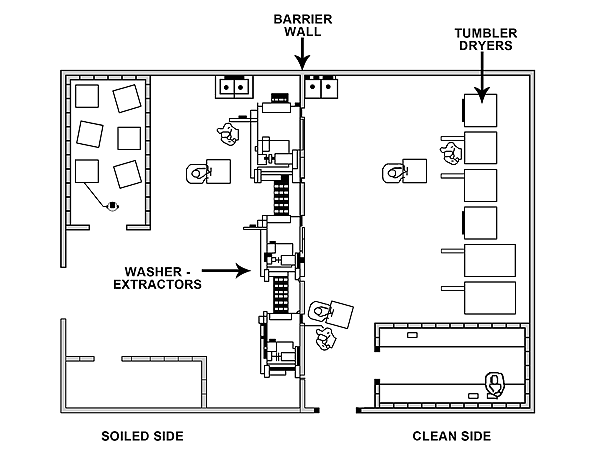Cross Contamination In Laundry
Nursing homes, hospitals, clean rooms and healthcare environments currently face ever-increasing risks of exposure to microbiological contamination. The threat of hospital-acquired infections (HAIs) - or "nosocomial infection" in medical jargon - can also have direct effects on laundry processing.
Patients have more contact with linens (sheets, blankets and gowns) than anything else while being treated in hospital. Because of this, HAIs are a serious threat. The separation of soiled, possibly contaminated, linen from clean linen is essential when trying to prevent cross contamination.
How does re-contamination of linens occur? When the patient's bed sheets are removed, they are placed in a contaminated-linens container. The sheets are then bagged and taken to the hospital laundry where an operative - who should be wearing protective gloves to avoid personal contamination - puts them into the washer-extractor. The machine door is closed, the wash cycle selected and the start button activated.
While the operative is protected from germs by wearing gloves, nothing protects the machine. During loading, the contaminated linens will have come into contact with the washer pocket rim, the machine's handle and operating switchgear. Other surfaces the operative may have touched will also have been exposed to germs.
Many installations spray these areas with disinfectant in an attempt to sanitize the surfaces, but it is critical the disinfecting process is performed correctly.
After disinfection, the following questions should be asked:
- Were all contaminated surfaces treated?
- Was the disinfectant strong enough?
- Was the proper amount used?
Upon completion of the wash cycle, the operative then moves the clean goods to the dryer. Once again, contact is made with the machine's handle before dragging the clean linens back over the washer pocket rim and into the laundry cart.
The correct washing chemicals, water temperature and mechanical action are vital in ensuring linens are laundered properly, but cross-contamination in nursing home, hospital, clean room and healthcare laundries can be avoided by using a barrier type washer-extractor. These machines are designed to keep soiled and clean goods physically separated during the wash process.
 |
EDRO's Barrier Type PassThru for Clean Rooms washer-extractor - available in 200 (91 kg) and 400 (182 kg) pound soft mount (DW_PTSM) models - is a specialized machine utilized in preventing cross contamination.
The washer is loaded from the soiled side and unloaded from the clean room side. This is physically separated by a barrier wall (see diagram). The machine is attached to the barrier wall by the "Clean Seal" sealing system. This exclusive system provides a physical barrier and positive air flow between the clean and soiled operating sides.
Built flush against the sides of the Clean Seal, the design provides total separation of loading and unloading operations with better and easier installation. An uninterrupted flow of positive make-up air from the clean room side to the soiled room side is continually flowed through the machine while in operation - thus preventing airborne cross-contamination of the load.
An interlocking door system prevents both doors from being opened at the same time so when an operative loads dirty laundry on the soiled side, the door cannot be opened on the clean side allowing germs to contaminate the clean room.
A smart control system prevents simultaneous soiled room and clean room operation of the machine. The washer's control panel is located on the washroom (loading) side. Forward and reverse jog controls, as well as signal and emergency stop switches are located on the unloading side.
A further aid in the sanitization of linens is the use of an ozone system. The DynOzone Disinfecting & Sanitizing Laundry System is a standard feature on all EDRO's PassThru machines. The system pairs a built-in, onboard ozone generator with a high-speed machine to produce a safe, disinfected and sanitized air stream which is injected into the wash wheel for markedly improved washroom efficiency.
PassThru for Clean Rooms washer-extractors have all the outstanding features that make EDRO washer-extractors extraordinary machines in design, construction and performance. The machines are equipped with a state-of-the art DynaTrol HMi Touch Screen Control. Coupled with the programmability of the HMi/PLC, these washer-extractors are able to deliver exacting cylinder RPMs for the best wash results from wash speeds through high extract. Multiple parameter settings allow high torque wash speeds with steep slope starts and stops and elongated slopes for even load distribution and acceleration to high extract.
High slip braking allows braking torque in excess of 100% of full load motor torque by controlling the deceleration from high speed to make the motor operate as a very efficient induction generator. The advantage of this method is no additional parts are required to stop the machine.
The machines also feature an inverter with single motor variable speed drive with high slip & positioning brake system. Inverter with single motor drive technology is a tremendous advance in machine speed control. The design has significantly fewer parts than conventional multiple-motor set-ups with single-speed motors, clutches and gearboxes, while delivering more speed selections and greater energy efficiency.
The patented "3-D" basket design assures an ideal wash action for outstanding laundering results. Stainless steel is used for the basket, shaft and shell wrap to guarantee long component life.
Typical installations for Barrier Type PassThru for Clean Rooms washer-extractors include hospitals, nursing homes, and clean room laundries. With the increasing demand of computer components, EDRO has also installed machines in clean room laundries of microprocessor and semi-conductor production plants.


